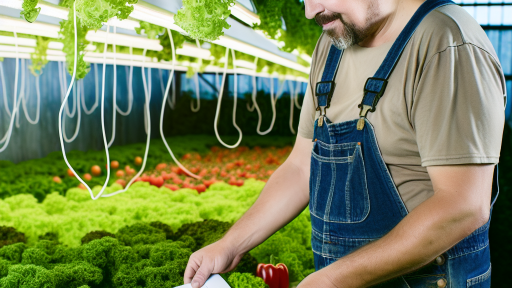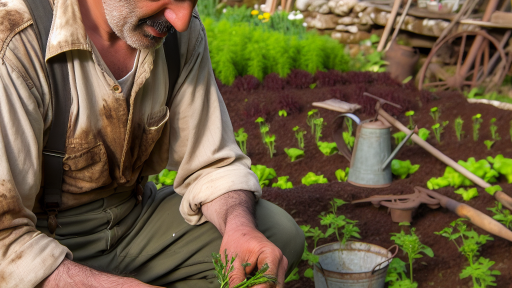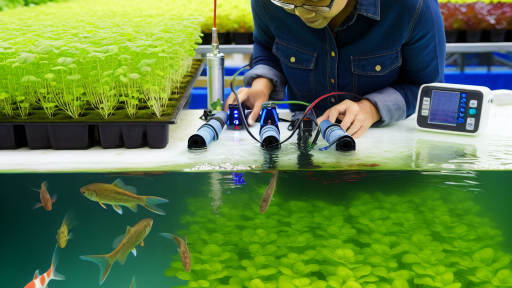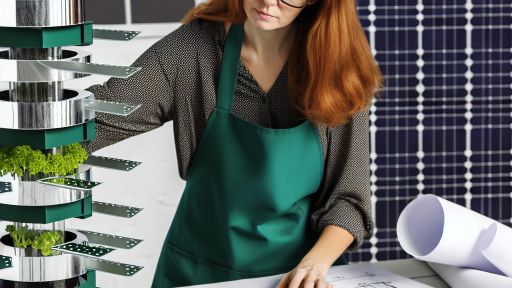Introduction to Heirloom Gardening Tools and Their Importance
Heirloom gardening tools hold rich history and craftsmanship.
These tools represent a connection to traditional agriculture.
Farmers and gardeners cherish them for their durability.
Using heirloom tools often improves efficiency in the garden.
Moreover, they can enhance the overall gardening experience.
These tools frequently come with unique features and designs.
Consequently, they blend functionality with aesthetic appeal.
Throughout generations, heirloom tools have proved their value.
They are often more reliable than modern counterparts.
Their construction reflects practices developed over centuries.
Preserving Tradition
Heirloom tools reflect a legacy of craftsmanship.
Many farmers appreciate the stories and techniques behind each tool.
As such, heirloom tools help to preserve agricultural culture.
Using them fosters a greater understanding of gardening traditions.
Enhancing Gardening Skills
Heirloom tools often require more skill to use effectively.
Transform Your Agribusiness
Unlock your farm's potential with expert advice tailored to your needs. Get actionable steps that drive real results.
Get StartedThis encourages gardeners to become more knowledgeable.
As a result, they learn the proper techniques for each tool.
Mastering these skills heightens one’s gardening competence.
Environmental Benefits
Many heirloom tools are made from sustainable materials.
They reduce reliance on disposable, plastic tools.
This contributes to a lower environmental impact overall.
Using heirloom tools can promote ecological consciousness.
Supporting Local Communities
Purchasing heirloom tools often supports local artisans.
Many of these tools come from small, family-owned businesses.
Thus, buyers contribute directly to their local economies.
Additionally, this helps to keep traditional craftsmanship alive.
The History of Heirloom Gardening Tools and Their Evolution
Origins of Heirloom Tools
Heirloom gardening tools have a rich history dating back centuries.
Early farmers crafted tools from available materials like wood and stone.
These primitive tools served essential purposes, enabling cultivation and harvest.
As societies advanced, so did the design and effectiveness of these tools.
Development Through the Ages
The Industrial Revolution brought significant changes to agriculture.
Mass production made tools more accessible to farmers everywhere.
However, many traditional designs remained in use due to their effectiveness.
Farmers valued these heirloom tools for their durability and practicality.
The Resurgence of Heirloom Tools
In recent years, there has been a revival of interest in heirloom tools.
This resurgence is rooted in a desire for sustainable and traditional farming practices.
Modern farmers appreciate the craftsmanship and reliability of these tools.
Furthermore, heirloom tools often reflect historical farming techniques, connecting generations.
Characteristics of Heirloom Tools
Heirloom gardening tools are typically handcrafted and made from high-quality materials.
Showcase Your Farming Business
Publish your professional farming services profile on our blog for a one-time fee of $200 and reach a dedicated audience of farmers and agribusiness owners.
Publish Your ProfileThey often feature ergonomic designs that enhance user comfort.
Additionally, these tools usually come with a timeless aesthetic appeal.
Farmers often find that they can be easily repaired and maintained, increasing longevity.
Significance in Modern Agriculture
Heirloom tools hold significance beyond functionality in modern agriculture.
They symbolize a connection to the past and a commitment to sustainable practices.
Furthermore, using heirloom tools fosters a deeper appreciation for the craft of farming.
They help preserve traditional methods that may otherwise be lost in industrial agriculture.
Essential Hand Tools Every Farmer Should Have
Hand Trowels
Hand trowels offer precision for planting and transplanting seedlings.
They allow farmers to dig, scoop, and spread soil easily.
A sturdy trowel is vital for any gardening task.
Pruning Shears
Pruning shears are essential for maintaining plant health.
They enable farmers to trim dead or overgrown branches efficiently.
Good quality shears make clean cuts, promoting healthier growth.
Garden Forks
Garden forks are perfect for breaking up compacted soil.
They help aerate the soil and incorporate organic matter effectively.
Forks are also useful for planting root vegetables.
Hand Rakes
Hand rakes are useful for leveling and preparing garden beds.
They help in removing debris and smoothing out soil surfaces.
Using a hand rake ensures an even seed bed for planting.
Weeders
Weeders assist in removing unwanted plants effectively.
They help maintain garden aesthetics and reduce competition for nutrients.
Investing in a good weeder saves time and effort in the long run.
Seed Drills
Seed drills ensure even seed distribution in the soil.
They automate the planting process, making it quicker and easier.
Accurate seed placement improves overall crop yield.
Soil Moisture Meters
Soil moisture meters provide crucial information for irrigation.
They help farmers determine when to water their crops.
Using these tools promotes water conservation and crop health.
Find Out More: Essential Nutrients for Hydroponic Growth
The Benefits of Using Heirloom Tools Over Modern Alternatives
Durability and Craftsmanship
Heirloom gardening tools exhibit superior craftsmanship compared to many modern options.
These tools often feature high-quality materials that withstand harsh conditions.
Furthermore, many heirloom tools undergo hand-forging, enhancing their durability over time.
In contrast, modern tools frequently use cheaper, less durable materials.
As a result, heirloom tools can last for generations with proper care.
Environmental Impact
Using heirloom tools supports sustainable gardening practices.
Many heirloom tools are crafted using environmentally-friendly methods.
This reduces reliance on mass-production processes that harm the environment.
Additionally, heirloom tools encourage a slower pace of gardening.
Gardening becomes a more mindful and rewarding activity.
Connection to Tradition
Heirloom tools often carry a rich history and personal stories.
Showcase Your Farming Business
Publish your professional farming services profile on our blog for a one-time fee of $200 and reach a dedicated audience of farmers and agribusiness owners.
Publish Your ProfileEach tool represents generations of gardening wisdom and practices.
This connection fosters a deeper appreciation for gardening traditions.
Using these tools links modern gardeners to their ancestors’ experiences.
Enhanced Gardening Experience
Heirloom tools can improve overall gardening enjoyment and satisfaction.
Many gardeners report a more tangible connection to their work while using these tools.
Moreover, heirloom tools often boast unique designs that enhance functionality.
The ergonomic shape of heirloom tools can reduce strain during use.
Support for Local Artisans
Purchasing heirloom tools typically supports local artisans and businesses.
Many heirloom tool makers prioritize craftsmanship and quality over mass production.
Supporting these artisans bolsters local economies and communities.
Thus, choosing heirloom tools contributes to ethical consumerism.
Learn More: Protecting Heirloom Varieties from Pests
Care and Maintenance of Heirloom Tools for Longevity
Regular Cleaning
Regular cleaning is essential for heirloom tools.
After each use, wipe down tools to remove dirt and debris.
This practice helps prevent rust and decay.
Use warm soapy water for stubborn grime.
Allow tools to dry completely before storage.
Proper Storage Techniques
Correct storage extends the life of heirloom tools.
Store tools in a dry and cool environment.
Hang or rack tools to prevent contact with moisture.
Avoid damp basements or garages for storage.
Using protective covers can shield tools from dust.
Sharpening and Maintenance
Regularly sharpen cutting edges to maintain efficiency.
Use a whetstone or sharpening tool for this task.
Check tools for any signs of wear or damage.
Addressing small issues early helps avoid major repairs.
Apply oil to metal parts to prevent rusting.
Wood Care for Wooden Handles
Heirloom tools often have wooden handles that need care.
Regularly apply mineral oil to keep wood supple.
Avoid letting the wood dry out as it can splinter.
Inspect handles for cracks or signs of stress.
Replace damaged handles promptly to ensure safety.
Seasonal Inspection
Perform a thorough inspection at the beginning of each season.
Look for rust, wear, or loose parts that need attention.
Clean tools before the gardening season begins.
This ensures they’re ready for use when needed.
A seasonal checklist can streamline this process.
Explore Further: Enhancing Biodiversity with Heirloom Varieties
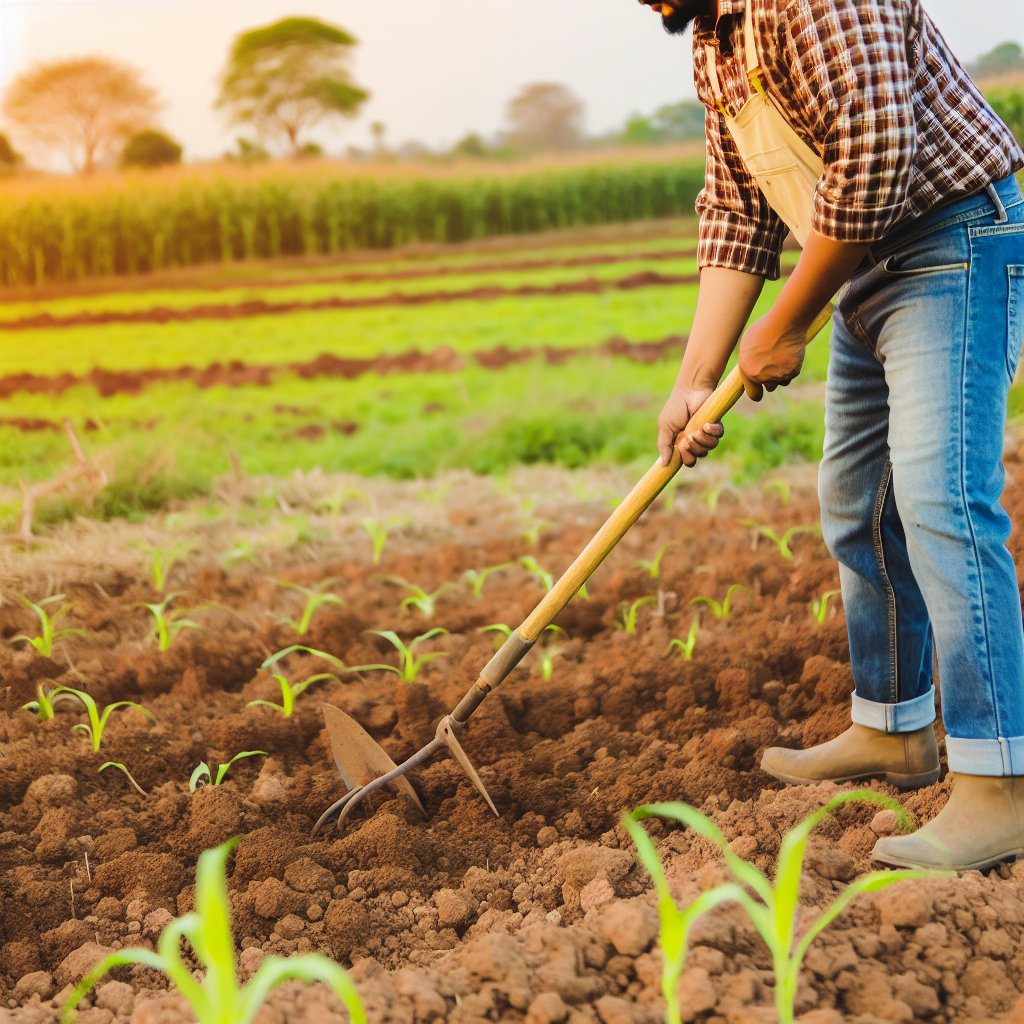
Top 5 Must-Have Heirloom Gardening Tools and Their Features
Handcrafted Wooden Hoe
A handcrafted wooden hoe is essential for any gardener.
It features a strong, durable handle made from oak.
Showcase Your Farming Business
Publish your professional farming services profile on our blog for a one-time fee of $200 and reach a dedicated audience of farmers and agribusiness owners.
Publish Your ProfileThe hoe blade is designed for optimal soil turning and weeding.
Additionally, its ergonomic design reduces strain on your hands.
Traditional Metal Trowel
The traditional metal trowel excels in planting and digging tasks.
This tool is made of high-quality stainless steel for longevity.
Its pointed blade penetrates soil effortlessly.
Moreover, the comfortable grip enhances user control.
Classic Garden Rake
A classic garden rake organizes soil and clears debris efficiently.
The tines are durable, ensuring effective raking every time.
Additionally, its wooden handle provides strength and stability.
This tool is perfect for preparing garden beds.
Vintage Pruning Shears
Vintage pruning shears are crucial for maintaining healthy plants.
These shears offer sharp blades for clean cuts.
They come with a sturdy spring mechanism for ease of use.
Furthermore, they minimize damage to branches and stems.
Heirloom Seed Collection
An heirloom seed collection promotes biodiversity in the garden.
These seeds are open-pollinated and non-GMO.
They yield unique, flavorful produce unlike commercial options.
Additionally, growing heirloom varieties supports sustainable practices.
See Related Content: Maximizing Yields in Hydroponic Systems
How to Source and Identify Authentic Heirloom Tools
Understanding Heirloom Gardening Tools
Heirloom gardening tools offer functionality and a connection to history.
They are typically handcrafted and designed to last for generations.
Farmers favor these tools for their durability and quality over mass-produced options.
Identifying Authentic Tools
Start by researching the history of heirloom tools.
Look for manufacturers known for traditional craftsmanship.
Examine tools for signs of wear and age, indicating authenticity.
Inspect materials; authentic heirloom tools often use high-quality metals and hardwoods.
Where to Source Heirloom Tools
Visit local antique shops for hidden treasures.
Explore estate sales, where heirloom tools may be available.
Attend farmer’s markets, where artisans may sell handmade tools.
Utilize online platforms for purchasing second-hand heirloom tools.
Verifying Value and Authenticity
Consult reputable appraisers familiar with heirloom tools.
Read reviews of sellers online to gauge their credibility.
Seek out tool collector communities for advice and recommendations.
Join forums dedicated to heirloom gardening for support.
Maintaining Your Heirloom Tools
Regular maintenance will ensure longevity and performance.
Clean tools after each use to keep them in optimal condition.
Sharpen blades regularly to maintain cutting efficiency.
Store tools in a dry, protected area to prevent rust and damage.
Preserving Heirloom Tool Traditions
Importance of Heirloom Tools
Heirloom tools connect farmers to the past.
They embody craftsmanship and time-honored techniques.
Showcase Your Farming Business
Publish your professional farming services profile on our blog for a one-time fee of $200 and reach a dedicated audience of farmers and agribusiness owners.
Publish Your ProfileUsing these tools promotes sustainability in farming.
Each tool has a unique story that enriches its value.
Identifying Authentic Heirloom Tools
Research tool origins to distinguish authentic heirlooms.
Consult reputable collectors and historical societies.
Attend agricultural fairs to view traditional tools firsthand.
Look for characteristics such as wear marks and craftsmanship.
Restoration and Maintenance Tips
Proper care extends the life of heirloom tools.
Clean tools regularly using natural solutions like vinegar.
Oil wooden handles to prevent drying and cracking.
Sharpen blades using a whetstone for optimal performance.
Community Resources for Heirloom Tools
Local gardening clubs often share resources about heirloom tools.
Online forums allow enthusiasts to exchange tips and stories.
Consider visiting museums with agricultural exhibits.
Find workshops that teach restoration techniques and stories.
Keeping Traditions Alive
Teach younger generations about heirloom tools.
Organize tool-sharing programs within local communities.
Document family histories related to heirloom gardening.
Celebrate local agricultural heritage through festivals and events.
Additional Resources
What are some possible Cash Crops available to the small farmer …
Micro Farming: Growing Wheat in Your Backyard : 4 Steps (with …

